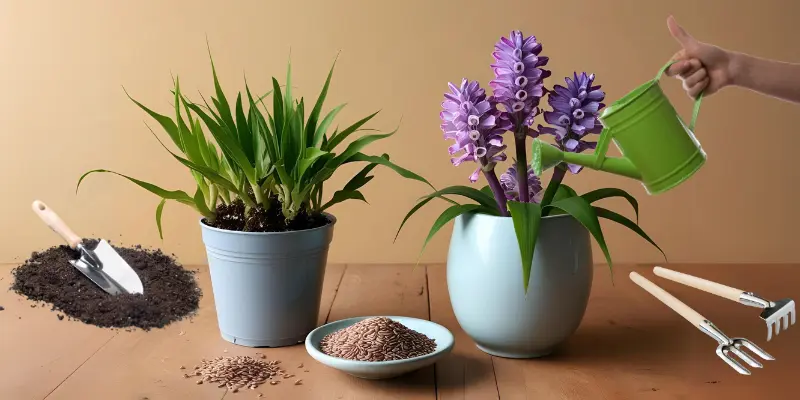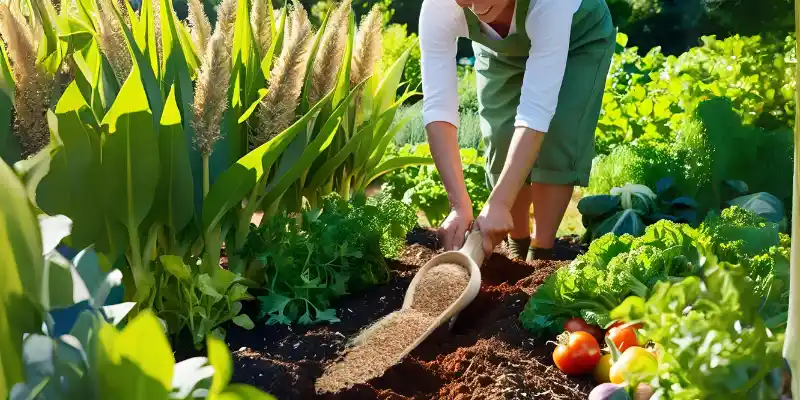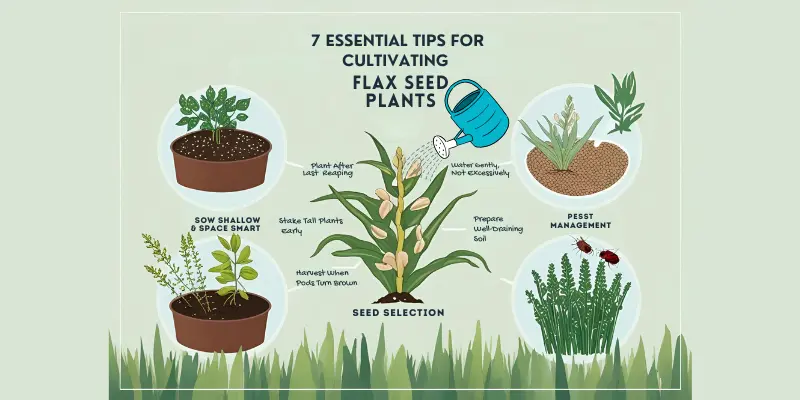How to Grow Flax Seed Plant: A Friendly Guide for Beginners & Nature Lovers
Published: 11 Apr 2025
Hey, nature explorer! 🌟
Does growing flaxseed sound like a challenge? Think of it like baking your favourite recipe: simple and rewarding with the right ingredients and steps. Growing flax seed plants is just as easy once you understand the basics. Whether you are new to gardening or a seasoned eco-enthusiast, learning how to grow flax seed plant is a satisfying hobby.
Hi, I’m Sheila, and with seven years of experience in botany, I’ve had my fair share of gardening successes (and a few flops!). In this article, I’ll share my knowledge and walk you through everything you need to know about growing flaxseed plants—from planting to harvest. You’ll find all the steps laid out to help you succeed.

You’ll feel confident growing flax in your backyard or balcony by the end. Ready to start your gardening journey? Let’s explore how easy it can be to grow flax seed plants!
How to Grow Flax Seed Plant: Step-by-Step Guide
Growing flax is simpler than you might expect. Just like baking a loaf of homemade bread, it all comes down to using the right ingredients at the right time. With sunlight, healthy soil, and patience, you’ll be watching those slender green stalks grow in no time.

Let’s walk through each step together—from selecting the right seeds to enjoying your first harvest.
Choosing the Right Flax Seeds
Start with whole, raw flax seeds—avoid roasted, ground, or pre-treated. Look for organic and untreated seeds for the best germination results.
You can choose golden or brown flax; both grow well, but golden is more delicate. In my garden, I’ve noticed that golden flax thrives exceptionally well in loamy, well-drained soil with full sunlight.
🌼 Personal Tip: I once tried planting store-bought flax from a baking aisle—it was only half sprouted. When I switched to a seed supplier, the success rate doubled!
2. Best Time & Place to Grow Flax
Flax grows best when planted in early spring, right after the danger of frost passes. Choose a sunny, open space with well-drained soil—they don’t like wet roots.
I’ve grown flax in raised beds, tucked between rows of herbs, and even in wide, shallow containers on my porch. They’re happy if they get 6–8 hours of sun!

From My Porch: One spring, I planted flax in a neglected corner of my balcony. I was surprised by how quickly it lifted and how lovely the blue flowers were mixed with my potted marigolds.
How to Plant Flax Seeds
Sow the seeds right into the soil, about ¼ inch deep. For linen, scatter densely. Space them around 4 inches apart for seed harvest for better airflow and pod development.
Water gently and regularly—just enough to keep the soil moist. You should see sprouts within 7 to 10 days.
My First Try: I remember using a ruler to space the seeds perfectly. It felt boring at first, but it made weeding easier later on and gave the plants enough room to stretch. The sprouts came up within a week—my niece called them “flax babies! 🧑🌾
4. Watering, Maintenance, and Troubleshooting
Flax likes even moisture, so water moderately and let the top inch of soil dry out between waterings. Avoid soaking—too much water can cause root rot.
Look for aphids or fungal spots, especially during humid weather. Flax is relatively low-maintenance, but I learned to gently tie the taller plants with string to help them stand up straight when they started to depend.
🚿 Lesson Learned: One season, I overwatered during a heatwave, resulting in droopy stems and yellow leaves. Since then, I have used a simple finger test: if the top inch is dry, it’s time to water.
5. Harvesting Flax Seeds
You’ll know it’s time to harvest when the seed pods turn golden brown and make a soft sound when you shake them. Cut the stems near the bottom and hang them upside down in a cool, shaded spot to dry.
After about a week, crush the pods gently over a cloth to release the seeds. I like to rub them between my palms—messy but satisfying!
🧺 Harvest Highlight: My first harvest yielded nearly a cup of seeds from a tiny 4×4 bed. I roasted some for granola and saved the rest to plant next season. It felt like closing a beautiful loop—from soil to seed to spoon.
⚠️ Precautions & Limitations When Growing Flax Seed Plant
While flax is generally low-maintenance, a few key precautions can make a big difference in your success. Understanding these early on can help you avoid common beginner mistakes and grow stronger, healthier plants. 👇
|
Why Grow Your Own Flax Seed Plant?
Growing flaxseed is like adding a tiny wellness lab to your garden. It’s a simple, rewarding way to support your health, reduce waste, and learn more about the natural world—right from your backyard.
Health Benefits: A Tiny Powerhouse
Flax seeds have omega-3 fatty acids, fiber, and lignans—a triple boost for heart health, digestion, and inflammation control. Adding just a spoonful of homegrown flax to your smoothie or oatmeal can feel like nature’s multivitamin.
Personal Experience: In my kitchen🥣, I grind the seeds fresh and sprinkle them over yogurt—my go-to morning energy boost!
🌎 Eco-Friendly: No Waste, All Wonder
One plant, many uses. From nutritious seeds to natural fibers for crafts or composting, nothing goes to waste. Growing flax is like having a mini eco-loop in your garden—everything you harvest gives back.
Personal insight: I even used the leftover stalks as a natural cover for the soil in my herb garden—it was a great way to reuse them.
👩🏫 Educational: A Living Science Project
Flax is fast-growing, easy to care for, and fascinating to observe—making it perfect for kids, classrooms, or beginner gardeners. Watching it bloom with its delicate blue flowers and then set seed is like witnessing a complete plant life cycle in slow motion.
My kids loved measuring the sprouts weekly and drawing them for their school nature journal.
🌍 Sustainable Living: Grow Your Superfood
When you grow Flax, you’re not just planting a seed—you’re planting a lifestyle. It’s a small but powerful step toward sustainable, self-reliant living. Whether you’re homesteading or just starting a patio garden, Flax is one of the easiest superfoods to grow at home.
Personal Experience: Flax was one of the first plants I tried when I began shifting toward homegrown wellness, and it’s still a favourite.
Can You Grow Flax in Pots or Small Spaces?
Absolutely! Flax doesn’t demand a considerable backyard—it’s more flexible than you’d think. With the right container and care, you can easily grow it on a balcony, in a backyard area, or on a sunny windowsill.
Choose the Right Container
Use wide, shallow pots (at least 6–8 inches deep) with good drainage holes. Flax has a shallow root system, so it thrives in broader containers where roots can spread without going deep. Think of it as giving the plant a soft lounge chair instead of a deep tunnel.
My Observation: I grew flax in a repurposed wooden crate on my apartment balcony. It bloomed beautifully and added charm to the space.
Sunlight & Soil Still Matter
Flax needs full sun and well-drained, loose soil, even in pots—just like in a garden bed. Add a little compost or organic mix to boost nutrients, and avoid overwatering (wet pots can quickly cause root rot).
A little tip: I learned the hard way that too much water in a ceramic pot with poor drainage made my first batch wilt—lesson learned!
Bonus: Small-Space Beauty
Container flax grows well, and its delicate blue flowers make it a lovely natural decor piece. It’s an easy win for small-space gardeners who want beauty and nutrition in one pot.
Organic & Sustainable Gardening with Flax
Flax isn’t just easy to grow—it’s a wise choice for gardeners who care about health, the environment, and garden harmony. From pest resistance to pairing beautifully with herbs, flax supports your plants and your purpose.

No pesticides or chemicals needed
- Flax naturally resists most pests, making it perfect for organic gardening.
- Spray or synthetic fertilizers are unnecessary—great for pollinators and kids’ gardens.
Personal tip: I never had to spray my flax—bees buzzed around it happily while it grew strong
Excellent companion plant for herbs and flowers
- Grows well with basil, chamomile, marigolds, calendula, and other friendly plants.
- It helps support healthy garden biodiversity while blending beautifully with other greenery.
Personal tip: I love planting flax beside herbs—it acts like a gentle border and keeps everything alive and fresh.
Adds beauty and diversity to your garden
- Flax’s slender stems and soft blue flowers bring a calming, airy touch to your space.
- It’s a sustainable addition that looks good and gives back.
Personal tip: Flax was one of my first steps toward eco-gardening. It filled in the empty spots and gave me seeds and smiles.
7 Growing Tips for How to Grow Flax Seed Plant
Growing flaxseed plants is simple when you follow a few key steps. These easy tips will help you plant, care for, and harvest your flax successfully—even if you’re starting!
Choose Quality Seeds
- Use whole, raw flax seeds—preferably organic and untreated. Golden flax tends to germinate faster in light, loamy soil.
Plant After the Last Frost
- Flax thrives when sown directly outdoors in early spring. For best results, plant the seeds after the last frost is over and the weather starts to warm up.
Prep Well-Draining Soil
- Flax dislikes soggy roots. Use well-drained, loose soil enriched with compost to help seeds settle in and grow strong.
Sow Shallow & Space Smart
- Plant seeds about ¼ inch deep. For linen, scatter densely; for seed harvesting, space them 4 inches apart for airflow and healthier pods.

Water Gently, Not Excessively
- Keep the soil moist but not soaked. Overwatering can lead to fungal issues or weak root development.
Stake Tall Plants Early
- If your flax plants grow tall and lean, gently tie them with twine for support. This keeps them upright and healthier.
Harvest When Pods Turn Brown
- It’s time to harvest once the seed pods turn golden brown and rustle softly. Snip the stalks and dry them in a shaded, breezy spot.
| Trivia Facts |
|---|
|
Conclusion
In conclusion, growing flax seed is more than just enjoying its beautiful flowers—it’s about taking advantage of nature’s simplicity. Flax requires minimal fertilizer and resists pests, making it a great, eco-friendly choice for gardeners. Following the tips above, you can create the ideal environment for your flaxseed plant to thrive.
Based on my experience growing flax, I suggest starting with quality seeds and ensuring good soil drainage for the best results.
Don’t wait—start learning how to grow flax seed plant today and enjoy a flourishing, sustainable garden!
Frequently Asked Questions About How to Grow Flax Seed Plant
Before diving into the details, you may have questions about growing flax seed plants. Don’t worry; I’ve got you covered with these easy-to-understand answers!
Plant flax seeds in early spring after the last frost. They thrive in moderate temperatures and need plenty of sunlight to grow well. Planting too early can risk frost damage, so wait until the weather is consistently warm.
Plant your flax seeds about ¼ inches deep into the soil. Flax seeds don’t need to be buried too deep, as they germinate easily in shallow soil. The soil should be loose and well-drained for seed growth.
Flax likes moist, well-drained soil, so water it lightly but regularly. Avoid overwatering, as flax doesn’t do well in soggy soil. When the earth feels dry on top, water the plant without overwatering.
Flaxseed plants are ready to harvest when the seed pods turn golden brown and make a soft rattle. At this point, the seeds are fully matured. Gently cut the stalks and allow them to dry in a shaded area before collecting the seeds.
Flax is pest-resistant, but occasionally, you may see aphids or fungal spots. Look for any discoloration or pests and remove them manually or with an organic insecticide if necessary. Good air circulation and moderate watering can help prevent these issues.
Flax typically takes about 70 to 90 days to grow, from seed to harvest. The germination takes about 7-10 days, and the plant matures in about 3 months. Once your flax blooms, it’s a sign that the seeds are developing and nearing harvest.
Most flax seeds are non-GMO and open-pollinated, which means they haven’t been genetically modified and grow naturally from seed. They are rarely hybrid, so you can safely save seeds from your plants to replant next season. For best results, choose flax seeds labelled “organic,” “heirloom,” or “non-GMO” to keep your garden natural and chemical-free.
| Reference Sources |
|---|

- Be Respectful
- Stay Relevant
- Stay Positive
- True Feedback
- Encourage Discussion
- Avoid Spamming
- No Fake News
- Don't Copy-Paste
- No Personal Attacks



- Be Respectful
- Stay Relevant
- Stay Positive
- True Feedback
- Encourage Discussion
- Avoid Spamming
- No Fake News
- Don't Copy-Paste
- No Personal Attacks





